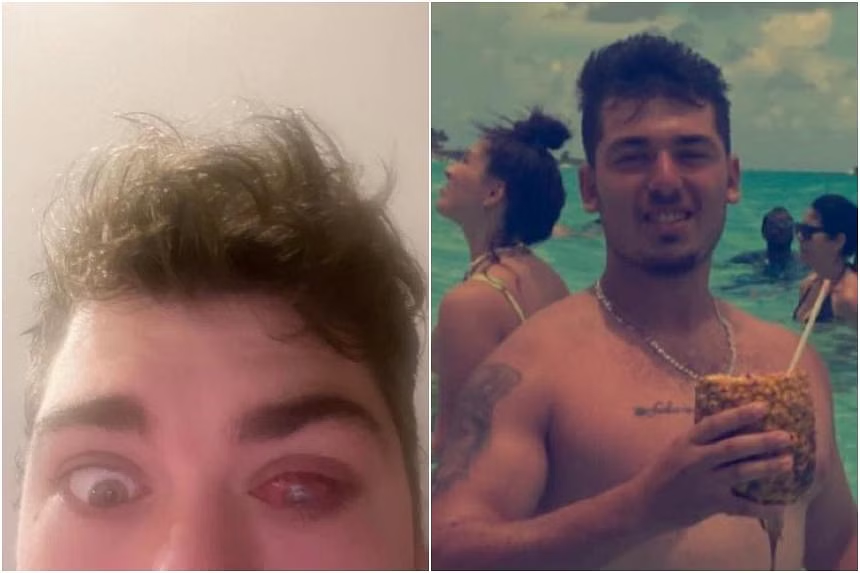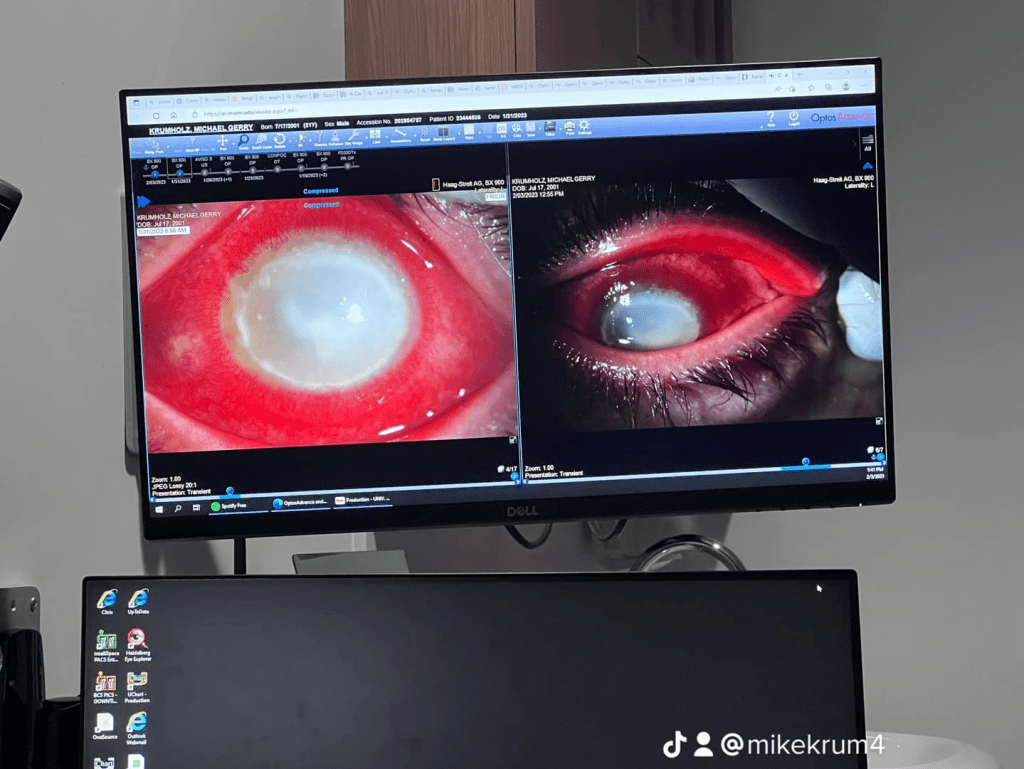We often take our eyesight for granted, trusting that simple habits like wearing contact lenses won’t lead to irreversible consequences. But for Chad Groeschen, a Cincinnati man who relied on his “Night and Day” contacts for convenience, this trust was shattered when he woke up with excruciating pain and a loss of vision. The very lenses that were supposed to enhance his life instead brought him to the brink of blindness. This is his story—a cautionary tale that serves as a stark reminder of the risks associated with improper contact lens use.

In 2015, Chad Groeschen, then 39, awoke with unbearable pain in his left eye. His vision had turned cloudy, and by the end of the day, he could barely see. What he initially dismissed as a mild irritation, perhaps due to allergies, quickly escalated into a severe medical emergency.
Groeschen had been using “Night and Day” contacts, marketed for continuous wear of up to 30 days. Believing that less frequent handling of his lenses would be better for his eyes, he would often leave them in for days at a time, removing them only once a week. He thought he was being cautious—but he couldn’t have been more wrong.
When Groeschen sought medical help, he was diagnosed with a corneal ulcer infected with Pseudomonas bacteria, a common but dangerous pathogen that thrives in moist environments. The contact lens, which had been left in overnight repeatedly, acted like a petri dish, cultivating the bacteria that ultimately attacked his eye.
Within days, Groeschen lost sight in his left eye. Doctors informed him that he would likely need a corneal transplant to restore any vision, but there was no guarantee of a full recovery. The very lenses that allowed him to see clearly had now left him partially blind, with a long and uncertain road ahead.
Groeschen’s case is not an isolated incident. A study by the American Academy of Ophthalmology in 2013 revealed that wearing contact lenses overnight significantly increases the risk of corneal infections, regardless of the type of lenses used. Extended wear might be convenient, but it’s far from safe.
The Centers for Disease Control and Prevention (CDC) has also weighed in, highlighting that the majority of the 41 million contact lens wearers in the U.S. engage in at least one risky behavior that puts their vision in danger. Among the most common are sleeping in lenses, topping off solution instead of replacing it, and neglecting to clean lenses properly. These habits, while seemingly minor, can lead to severe eye infections, and in some cases, permanent blindness.

In December 2022, another young man, Mike Krumholz, now 22, faced a similar fate after taking a 40-minute nap with daily disposable contacts still in his eyes. When he woke up, he felt an itch and noticed his eye was sensitive to light. Like Groeschen, Krumholz initially thought it was just allergies. But his condition quickly worsened.
Krumholz was diagnosed with an infection caused by Acanthamoeba keratitis, a rare but serious parasite that can cause blindness. The doctors told him that even a short nap with contacts in could have allowed the organism to infect his cornea. His prognosis is grim—he may need a corneal transplant, and even then, full recovery of his vision is unlikely.
Sleeping in contact lenses, even those designed for extended wear, reduces the amount of oxygen that reaches the cornea. This lack of oxygen can cause the cornea to swell, making it more susceptible to infection. Additionally, bacteria and other microorganisms can become trapped between the lens and the eye, leading to serious infections like those experienced by Groeschen and Krumholz.
Pseudomonas bacteria are among the most common causes of contact lens-related infections. They can rapidly multiply in the moist environment provided by contact lenses, particularly when worn overnight. Acanthamoeba, on the other hand, is a waterborne parasite that can infiltrate the eye through contact lenses, particularly if exposed to water while swimming or showering. Both infections are difficult to treat and can lead to significant vision loss.

To avoid the risks associated with contact lens use, the CDC recommends several key practices:
- Always Wash Your Hands: Before handling contact lenses, wash your hands thoroughly with soap and water, then dry them with a clean towel.
- Remove Lenses Before Sleeping: Never sleep in your contact lenses unless specifically prescribed by your eye doctor for extended wear.
- Avoid Water Exposure: Take out your lenses before swimming or showering to prevent exposure to harmful microorganisms.
- Properly Clean and Store Lenses: Rub and rinse your lenses with disinfecting solution each time you remove them. Never reuse old solution—always use fresh solution.
- Replace Lens Cases Regularly: Lens cases should be replaced at least every three months to avoid contamination.
- Carry Backup Glasses: Always have a backup pair of glasses on hand in case you need to remove your lenses unexpectedly.
If you experience any discomfort, redness, or changes in vision, remove your lenses immediately and seek medical attention. As Groeschen and Krumholz’s stories illustrate, the consequences of delaying treatment can be devastating.
Chad Groeschen’s experience serves as a powerful reminder of the importance of proper contact lens hygiene. The convenience of extended-wear lenses is tempting, but the risks are far too great to ignore. By following the recommended guidelines and listening to your body’s signals, you can protect your vision and avoid the painful, life-altering consequences of a preventable eye infection.


